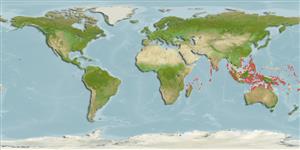>
Ovalentaria/misc (Various families in series Ovalentaria) >
Pomacentridae (Damselfishes) > Pomacentrinae
Etymology: Neopomacentrus: Greek, neos = new + Greek,poma = cover, operculum + Greek,kentron = sting (Ref. 45335).
More on author: Bleeker.
Environment: milieu / climate zone / depth range / distribution range
Ecologia
marinhas associadas(os) a recifes; não migratória; intervalo de profundidade 1 - 12 m (Ref. 7247). Tropical; 22°N - 18°S
Indo-West Pacific: East Africa to the Indo-Malayan Archipelago and Vanuatu, north to Taiwan, south to northern Australia, New Guinea, and the Solomon Islands.
Tamanho / Peso / Idade
Maturity: Lm ? range ? - ? cm
Max length : 7.5 cm TL macho/indeterminado; (Ref. 48636)
Descrição suscinta
Chaves de identificação | Morfologia | Morfometria
Espinhos dorsais (total) : 13; Raios dorsais (total) : 11 - 12; Espinhos anais: 2; Raios anais : 11 - 12.
Usually found in outer reef slopes and frequently in the deeper surge channels or adjacent ledges. Form small groups in sub-tidal habitats (Ref. 48636). Oviparous, distinct pairing during breeding (Ref. 205). Eggs are demersal and adhere to the substrate (Ref. 205). Males guard and aerate the eggs (Ref. 205). Diurnal species (Ref. 113699).
Ciclo de vida ou comportamento de acasalamento
Maturities | Reprodução | Spawnings | Egg(s) | Fecundities | Larvas
Oviparous, distinct pairing during breeding (Ref. 205). Eggs are demersal and adhere to the substrate (Ref. 205). Males guard and aerate the eggs (Ref. 205).
Allen, G.R., 1991. Damselfishes of the world. Mergus Publishers, Melle, Germany. 271 p. (Ref. 7247)
Status na Lista Vermelha da UICN (Ref. 130435)
Ameaça para os humanos
Harmless
Uso pelos humanos
Pescarias: espécies comerciais; Aquário: Espécies comerciais
Ferramentas
Relatórios especiais
Baixar XML
Fontes da internet
Estimates based on models
Preferred temperature (Ref.
123201): 27 - 29.3, mean 28.7 °C (based on 2096 cells).
Índice de diversidade filogenética (Ref.
82804): PD
50 = 0.5000 [Uniqueness, from 0.5 = low to 2.0 = high].
Bayesian length-weight: a=0.01862 (0.01165 - 0.02977), b=2.94 (2.80 - 3.08), in cm total length, based on LWR estimates for this species & (Sub)family-body (Ref.
93245).
Nível Trófico (Ref.
69278): 3.4 ±0.45 se; based on food items.
Resiliência (Ref.
120179): Elevada, tempo mínimo de duplicação da população menor que 15 meses (Preliminary K or Fecundity.).
Fishing Vulnerability (Ref.
59153): Low vulnerability (10 of 100).
Nutrients (Ref.
124155): Calcium = 153 [75, 261] mg/100g; Iron = 0.973 [0.541, 1.673] mg/100g; Protein = 18.3 [17.1, 19.5] %; Omega3 = 0.119 [0.063, 0.212] g/100g; Selenium = 18.6 [9.0, 39.3] μg/100g; VitaminA = 165 [48, 556] μg/100g; Zinc = 1.7 [1.1, 2.5] mg/100g (wet weight);
